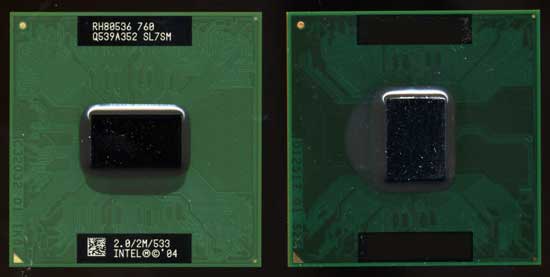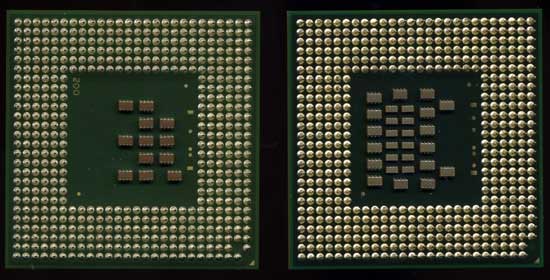Intel Core Duo (Yonah) Performance Preview - Part II
by Anand Lal Shimpi on December 19, 2005 12:55 PM EST- Posted in
- CPUs
It's called the Core Duo
When Yonah first started appearing on roadmaps, we knew it as Jonah, which then starting being written as Yonah. Eventually, Intel confirmed its existence and we had always assumed that it would continue to use the name Pentium M. However, given the great importance of the launch of Intel's first dual-core, low power, notebook processor, it shouldn't be much of a surprise that Intel has a new name in store for it. As you've probably already heard, Yonah will receive the marketing name "Core" with the words "Duo" or "Solo" following it depending on whether it is the dual or single core version. The name Centrino will still be there, but instead of referring to the processor as a Pentium M, it'll be called a Core Duo or a Core Solo. The Centrino platform itself will be referred to as Centrino Duo when paired with a Core Duo processor. We have to admit, we kind of like the new name.
Not so pleasant, however, are the new processor numbers that go along with the new processor names. Gone are Intel's simple three-digit numbers and they have since been replaced with a four-digit number preceded by a letter. The letter indicates the thermal envelope of the processor, while the following four digits denote the performance level of the CPU. If you think that this sounds oddly similar to AMD's Turion processor nomenclature, don't worry; you'd be completely right (of course, the Turion only uses two numbers, while Core Duo uses four). Maybe, one of these days, Intel will get around to copying some more important elements of AMD's history, such as an on-die memory controller or at least a serial bus interface.
As an example of the numbers in use, the 2.0GHz processor that we previewed in the first article will be sold under the name "Intel Core Duo T2500". For your reference, the T2600 will run at 2.16GHz (compared to the 2.0GHz T2500). The Core Solo processors will feature a "1" after the "T" denoting a single core; for example, the Intel Core Solo T1300 will run at 1.66GHz.
Intel's Core Duo and Solo processors both support a 667MHz FSB, which is enabled by the 945 chipset that Intel is pairing with them. The move to a 667MHz FSB is necessary, thanks to the increased bandwidth demands of a dual core processor.
As we mentioned in the first article, the Core Duo (and Solo) processors are not pin-compatible with the older Pentium M, even though they physically have the same number of pins.
When Yonah first started appearing on roadmaps, we knew it as Jonah, which then starting being written as Yonah. Eventually, Intel confirmed its existence and we had always assumed that it would continue to use the name Pentium M. However, given the great importance of the launch of Intel's first dual-core, low power, notebook processor, it shouldn't be much of a surprise that Intel has a new name in store for it. As you've probably already heard, Yonah will receive the marketing name "Core" with the words "Duo" or "Solo" following it depending on whether it is the dual or single core version. The name Centrino will still be there, but instead of referring to the processor as a Pentium M, it'll be called a Core Duo or a Core Solo. The Centrino platform itself will be referred to as Centrino Duo when paired with a Core Duo processor. We have to admit, we kind of like the new name.
Not so pleasant, however, are the new processor numbers that go along with the new processor names. Gone are Intel's simple three-digit numbers and they have since been replaced with a four-digit number preceded by a letter. The letter indicates the thermal envelope of the processor, while the following four digits denote the performance level of the CPU. If you think that this sounds oddly similar to AMD's Turion processor nomenclature, don't worry; you'd be completely right (of course, the Turion only uses two numbers, while Core Duo uses four). Maybe, one of these days, Intel will get around to copying some more important elements of AMD's history, such as an on-die memory controller or at least a serial bus interface.
As an example of the numbers in use, the 2.0GHz processor that we previewed in the first article will be sold under the name "Intel Core Duo T2500". For your reference, the T2600 will run at 2.16GHz (compared to the 2.0GHz T2500). The Core Solo processors will feature a "1" after the "T" denoting a single core; for example, the Intel Core Solo T1300 will run at 1.66GHz.
Intel's Core Duo and Solo processors both support a 667MHz FSB, which is enabled by the 945 chipset that Intel is pairing with them. The move to a 667MHz FSB is necessary, thanks to the increased bandwidth demands of a dual core processor.
As we mentioned in the first article, the Core Duo (and Solo) processors are not pin-compatible with the older Pentium M, even though they physically have the same number of pins.

Dothan (Pentium M) on the left, Yonah (Core Duo) on the Right

Dothan (Pentium M) on the left, Yonah (Core Duo) on the Right










103 Comments
View All Comments
fitten - Tuesday, December 20, 2005 - link
Yup... as I posted above... the rumor is that Yonah was designed for 2.5GHz (maybe even 2.6GHz or so) and can easily be overclocked to those speeds but is being launched at the speeds it is for exactly what you say... to fit in a certain power envelope.Xenoterranos - Tuesday, December 20, 2005 - link
We'll, that's definitely a logical argument, but I'd say only marginally relavent to this discussion. If a laptop with X% better power consumption comes out, does it really matter in the end where those X% came from. I can see the validity in saying that maybe some of those optimizations are on the board and thus the CPU shouldn't be given all the credit, but lower consumption is lower consumption. But that's all hypothetical. The reality is that even without optimizations, the Pentium M would have enjoyed lower power consumption just by moving to the 65nm proccess, as would any proccessor. that's where most of that 30% came from. I'd venture to say that the board design provides 1 or 2 % max, and definitely within the margin of error.><eno
Xenoterranos - Tuesday, December 20, 2005 - link
Um, i got confused there a bit. I'm basically saying that the new "Core Duo" derives the majority of it's efficiency not from any architectual changes (although they do help a lot), but from the move to 65nm. When AMD makes that jump to (and if Intel hasn't already gone to 45nm) then you'll see AMD pull ahead in power consumption on all 65nm parts, if not performance as well. Remember, aside from the on-die controller, this new architecture is very similar to what AMD is doing. Like the author said, if they wanted to copy something, they should at least copy the serial bus!Betwon - Tuesday, December 20, 2005 - link
All one know that Dothan is 90nm.But it is very cool. hot == Intel's 90nm? No!The CPU's architecture of low power consume is key. We must understand that IC design is very complex, many advanced tech are applied to keep CPU cool, include the CPU's architecture(such as micro-ops fusion).
Furen - Tuesday, December 20, 2005 - link
Yonah is better? It seems to be like its a pretty even match clock-for-clock but if you consider that X2s max out at 2.4GHz (currently) and Yonah will launch in around 15 days at 2.13GHz (the FX-60 is supposed to launch around the same time, so the X2 max clock may hit 2.6GHz when Yonah arrives) then it is clearly inferior in the performance department. Granted, the power consumption is quite a bit better but I'd hardly say that the CPU is better, just better suited for low-power applications.Betwon - Tuesday, December 20, 2005 - link
Yonah(2GHz/L2 2M) is better than AthonX2(2GHz/L2 2M) in the many cases.Everyone also believe that Yonah is able to reach the very high frequency.
In the past, We also known that PM can be overclocked better than A64. The PM's best record of Super Pi is much fast than A64/FX.
Zebo - Monday, December 19, 2005 - link
Yonah Yonah Yonah... Nah it was hype as I suspected... these procesors are vitually identical to AMD's old A-64's.. AMD supposed to get signifigant bumps w. DDR2/3 and PCIe onboard plus I read about some technology AMD and IBM made to increase performance by a whopping 40%!!http://www.guru3d.com/newsitem.php?id=3370">http://www.guru3d.com/newsitem.php?id=3370
AMD has nothing to fear other than in power arena when longer pipe Conroe comes and even then that advantage may very well disappear.
IntelUser2000 - Tuesday, December 20, 2005 - link
The 40% advantage is TRANSISTOR performance. Even then, its 40% advantage when no straining is included at all. AMD has strained silicon in their current process. Which means real advantage is FAR less than 40%.Shintai - Monday, December 19, 2005 - link
PCIe onboard is not a speed advantage. It´s more a tactic move towards the the computer on a chip solution.AMD is keen on ondie memory controller and in some years PCIe aswell due to the fact they suck at chipsets. Sure nVidia is making some good ones now. But it´s always been Intels extra strong point.
PCIe would also gives less traces on the motherboard that gives lower cost. But your CPU will break the 1300pin mark atleast and will be unable to scale in any way. Like AMDs backwards setting with DDR. When some new PCIe or more PCIe lanes comes out. You would need a new socket.
However personally I´m in favour of it. I just think AMDs ondie solutions is the wrong way. On package seems alot better and more flexible. Until we have an even more stagnant development cycle for external parts.
stateofbeasley - Monday, December 19, 2005 - link
DDR2 advantage? I wouldn't count on it. The latency on DDR2 still sucks compared to DDR. I wouldn't be so quick to scoff - Yonah performs as well as the X2 while consuming only a fraction of the electrical power.I don't see why people thought Yonah was going to be some sort of X2 destroyer. Its execution core has far fewer units than K8 and it lacks an on-die memory controler. The fact that it can match an X2 with slimmer cores makes it all the more impressive. The only hype was in your mind.
The AMD/IBM technology is not in processors that we can benchmark today -- they have yet to bring this process to mass manufacturing.